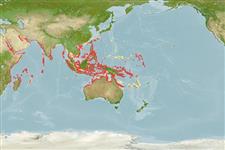Environment: milieu / climate zone / depth range / distribution range
Ecologia
marinhas associadas(os) a recifes; intervalo de profundidade 3 - 30 m (Ref. 90102), usually 5 - 20 m (Ref. 27115). Tropical; 22°C - 30°C (Ref. 27115); 30°N - 22°S, 32°E - 175°E
Indo-West Pacific: from Seychelles to Fiji; north to Japan, south to New Caledonia.
Tamanho / Peso / Idade
Maturity: Lm ? range ? - ? cm
Max length : 8.5 cm SL macho/indeterminado; (Ref. 48637)
Descrição breve
Chaves de identificação | Morfologia | Morfometria
Espinhos dorsais (total) : 7; Raios dorsais moles (total) : 15 - 17; Espinhos anais: 1; Raios anais moles: 15 - 16. This species is distinguished by the following characters: D VI + I,15-17; A I,15-16; pectoral-fin rays 16-17; scales in longitudinal series 49-54, in transverse series 17-18; interorbital wide, 67-90 % of eye diameter; rear margin of upper jaw ending posteriorly slightly behind or at vertical through anterior margin of eye; first two dorsal-fin spines filiform, elongate, remaining progressively shorter, the sixth dorsal-fin spine almost reaches the origin of the second dorsal; small ctenoid scales on body, cycloid at axil of pectoral fin, nape and entire belly, and in the area between first dorsal fin and pectoral fin; predorsal scales 16-22, scales not reaching to the vertical through the posterior edge of eye, ending at the level of pore G or H'; cheek and opercle naked; scales cover the basal 1/3-1/4 of caudal fin, becoming rapidly smaller and cycloid; prepectoral area with about 4-9 vertical series of fine cycloid scales covering the entire base of the pectoral fin; prepelvic area with cycloid scales, 9-14 in the midventral row; width at anal-fin origin 9.9-10.7% of SL; caudal peduncle depth 75.4-88.9% of its length; head depth 47.3-54.4% of HL; length of 11th second dorsal-fin ray 11.8-14.2% of SL; length of 8th anal-fin ray 13.7-14.9% of SL (Ref. 119548).
Inhabits sheltered bays and inner reefs on fine rubble shaded by large living corals (Ref. 48637). Occurs solitarily, hovering a short distance above sandy bottoms of reef bases. Stomach contents of one specimen comprise of filamentous algae, harpacticoid copepods, ostracods, amphipods, and nematodes (Ref. 9360).
Life cycle and mating behavior
Maturities | Reprodução | Spawnings | Egg(s) | Fecundities | Larvas
Kovačić, M., S.V. Bogorodsky, A.O. Mal and T.J. Alpermann, 2018. Redescription of the genus Koumansetta (Teleostei: Gobiidae), with description of a new species from the Red Sea. Zootaxa 4459(3):453-481. (Ref. 119548)
Categoria na Lista Vermelha da IUCN (Ref. 130435)
Ameaça para o homem
Harmless
Utilização humana
Pescarias: espécies comerciais; Aquário: Espécies comerciais
Ferramentas
Relatórios especiais
Descarregue XML
Fontes da internet
Estimates based on models
Preferred temperature (Ref.
123201): 24.7 - 29.2, mean 28.4 °C (based on 320 cells).
Phylogenetic diversity index (Ref.
82804): PD
50 = 0.6250 [Uniqueness, from 0.5 = low to 2.0 = high].
Bayesian length-weight: a=0.00708 (0.00333 - 0.01504), b=3.09 (2.92 - 3.26), in cm total length, based on LWR estimates for this (Sub)family-body shape (Ref.
93245).
Nível Trófico (Ref.
69278): 2.1 ±0.1 se; based on diet studies.
Resiliência (Ref.
120179): Elevada, tempo mínimo de duplicação da população menor que 15 meses (Preliminary K or Fecundity.).
Fishing Vulnerability (Ref.
59153): Low vulnerability (10 of 100).
Nutrients (Ref.
124155): Calcium = 162 [70, 326] mg/100g; Iron = 0.867 [0.407, 1.738] mg/100g; Protein = 17.4 [15.4, 19.2] %; Omega3 = 0.0835 [, ] g/100g; Selenium = 26 [12, 64] μg/100g; VitaminA = 114 [24, 529] μg/100g; Zinc = 2.67 [1.65, 4.09] mg/100g (wet weight);
